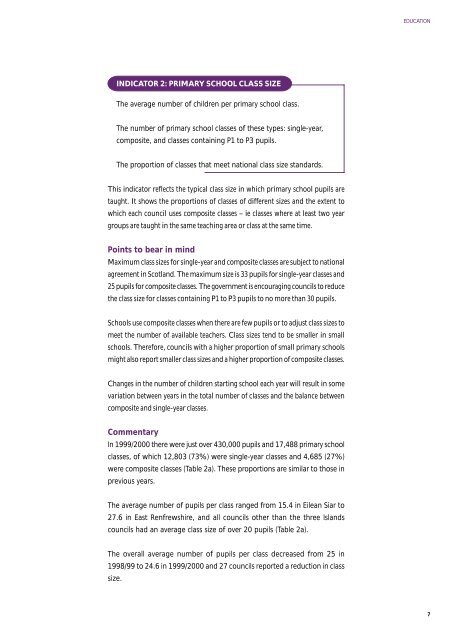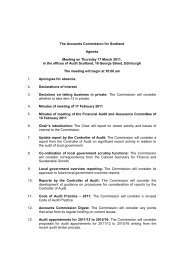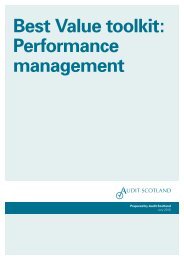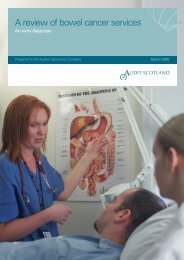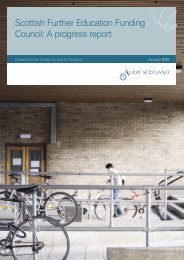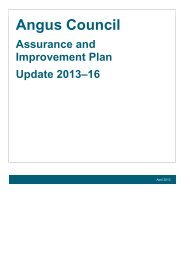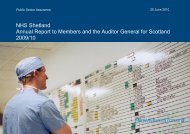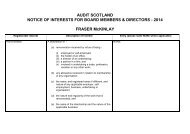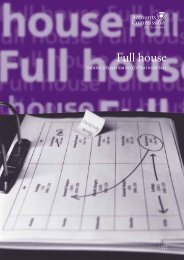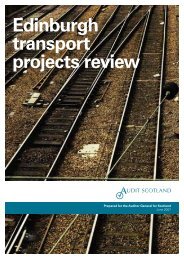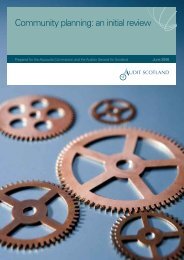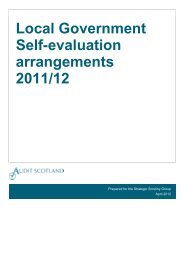Education services (PDF | 247 KB)Opens in new ... - Audit Scotland
Education services (PDF | 247 KB)Opens in new ... - Audit Scotland
Education services (PDF | 247 KB)Opens in new ... - Audit Scotland
Create successful ePaper yourself
Turn your PDF publications into a flip-book with our unique Google optimized e-Paper software.
EDUCATION<br />
INDICATOR 2: PRIMARY SCHOOL CLASS SIZE<br />
The average number of children per primary school class.<br />
The number of primary school classes of these types: s<strong>in</strong>gle-year,<br />
composite, and classes conta<strong>in</strong><strong>in</strong>g P1 to P3 pupils.<br />
The proportion of classes that meet national class size standards.<br />
This <strong>in</strong>dicator reflects the typical class size <strong>in</strong> which primary school pupils are<br />
taught. It shows the proportions of classes of different sizes and the extent to<br />
which each council uses composite classes – ie classes where at least two year<br />
groups are taught <strong>in</strong> the same teach<strong>in</strong>g area or class at the same time.<br />
Po<strong>in</strong>ts to bear <strong>in</strong> m<strong>in</strong>d<br />
Maximum class sizes for s<strong>in</strong>gle-year and composite classes are subject to national<br />
agreement <strong>in</strong> <strong>Scotland</strong>. The maximum size is 33 pupils for s<strong>in</strong>gle-year classes and<br />
25 pupils for composite classes. The government is encourag<strong>in</strong>g councils to reduce<br />
the class size for classes conta<strong>in</strong><strong>in</strong>g P1 to P3 pupils to no more than 30 pupils.<br />
Schools use composite classes when there are few pupils or to adjust class sizes to<br />
meet the number of available teachers. Class sizes tend to be smaller <strong>in</strong> small<br />
schools. Therefore, councils with a higher proportion of small primary schools<br />
might also report smaller class sizes and a higher proportion of composite classes.<br />
Changes <strong>in</strong> the number of children start<strong>in</strong>g school each year will result <strong>in</strong> some<br />
variation between years <strong>in</strong> the total number of classes and the balance between<br />
composite and s<strong>in</strong>gle-year classes.<br />
Commentary<br />
In 1999/2000 there were just over 430,000 pupils and 17,488 primary school<br />
classes, of which 12,803 (73%) were s<strong>in</strong>gle-year classes and 4,685 (27%)<br />
were composite classes (Table 2a). These proportions are similar to those <strong>in</strong><br />
previous years.<br />
The average number of pupils per class ranged from 15.4 <strong>in</strong> Eilean Siar to<br />
27.6 <strong>in</strong> East Renfrewshire, and all councils other than the three Islands<br />
councils had an average class size of over 20 pupils (Table 2a).<br />
The overall average number of pupils per class decreased from 25 <strong>in</strong><br />
1998/99 to 24.6 <strong>in</strong> 1999/2000 and 27 councils reported a reduction <strong>in</strong> class<br />
size.<br />
7


